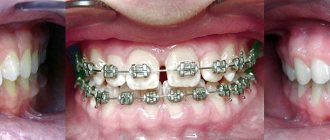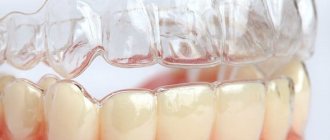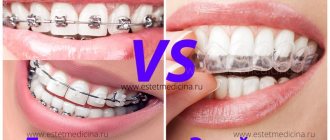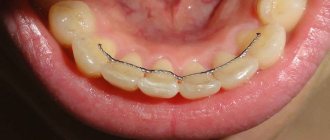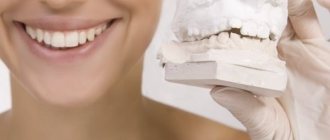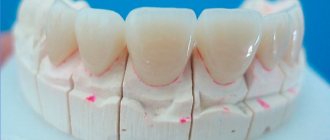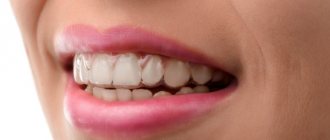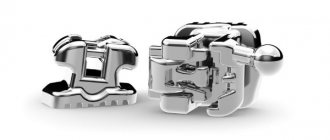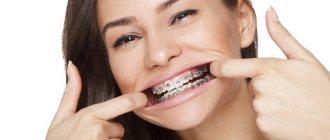What types of mouth guards are there?
Since this dental accessory is used not only in boxing, you can find mouth guards for different sports on sale. Therefore, before purchasing, you need to make sure of the intended purpose of the product. Conventionally, protection for teeth can be divided according to several criteria.
By purpose
According to the purpose of the mouthguards there are:
- Designed to protect the teeth of the upper jaw.
- Designed for both jaws (equipped with a special hole through which the athlete can breathe).
By material
Thermoplastic mouth guard
There are three types of boxing mouthguards for teeth:
- Hard standard (for those with perfectly straight teeth).
- Thermoplastic.
- Rigid, made according to an individual cast.
The best and most affordable material is thermoplastic. Thermoplastic aligners soften under the influence of hot water and then quickly cool, “remembering” the shape of the teeth. The main thing is to choose a product that is suitable in size.
Choosing the size of a mouthguard to protect your teeth and mouth must be very careful. In Moscow you can buy mouth guards of different sizes and thicknesses. A product that is the right size can be perfectly adjusted to fit your teeth; a size that is too large will not allow the item to stay in the mouth, and an accessory that is too small will cause discomfort and pain in the teeth.
By color
There are mouthguards for adults and children, in different colors and with different tastes. The most popular protective accessories are mint flavored.
As a natural antiseptic, mint provides additional protection against bacteria, and as a natural deodorant, it provides a feeling of freshness.
Sports mouthguard for braces Powrgard for braces
Description: Powrgard -Multifunctional protective device Experience and innovation
MRC, a developer and manufacturer of high-tech products for medicine and sports since 1990, a leader in the use of computer modeling to create intraoral devices, combining its experience in technology with knowledge of functional processes in the face and jaw, has developed the most advanced protective mouthguards to date industrial production. Minimal fitting time, excellent practical results and low cost (half the price of individual ones!) Powrgard protective mouth guards have made them highly popular among athletes.
Improved protection
— Double protection of the teeth of the frontal region - protection of the upper and lower jaw, as well as the TMJ
Improved Features
- allows air access when teeth are closed - increases strength and athletic performance
Improved design
— individual fit, not inferior to mouth guards made by vacuum method — possibility of multiple adjustments (if necessary).
Protective mouth guards are used by athletes in contact and extreme sports. However, most of them only protect the upper jaw from impact. Unprotected lower teeth are easily injured and require expensive treatment in the future. Even more serious problems—lifelong pain and discomfort—can occur with injuries to the temporomandibular joint (TMJ). Cheap plastic mouth guards, sold easily in stores, break and do not provide the required protection. Thermoplastic appliances, which soften when boiled, are made of a single material and are also unable to provide the necessary protection for teeth, since when biting, the material becomes thinner in the area of the front incisors, where the greatest protection is required. Individual laboratory-made mouthguards are not available to a wide range of athletes, as they require complex manufacturing (taking individual impressions, vacuum melting), and this lengthy and expensive process also does not guarantee the necessary protection in the area of the front teeth. Additionally, most mouthguards prevent the athlete from speaking, which causes discomfort. Improved athletic performance. In recent years, a number of studies have been conducted on improving athletic performance with the use of orthopedic intermaxillary appliances (OMA), in particular, increasing arm strength and endurance. Research has shown that such improvements are quite significant. According to research by Bates and Atkinson, high jumpers experienced an average improvement of 5%. The compression test records a 17.3% increase in reinforcement due to prosthetic mandibular support. When using sports mouthguards, a statistically significant increase in the strength of the shoulder girdle is observed. The influence of OMA on increasing the muscle strength of the shoulder girdle and upper extremities has also been recorded, in particular when playing those sports where the shoulder torque is actively used (tennis, baseball). A pronounced effect of OMA is also observed in American football players - an increase in athletic performance and a decrease in the frequency of injuries due to dual protection - Shock Transfer Core. The fundamentally new concept of modeling Powrgard sports mouth guards, proposed by MRC, has received recognition from sports doctors and dentists around the world. The successful combination of highly reliable protection with the advantages of OMA guarantees a significant increase in the athlete’s athletic performance: the thickened shape of the base ensures optimal mutual positioning of the jaws; four oblong holes provide the necessary oxygen access, even when the athlete’s teeth are tightly clenched and the movement of the lower jaw is limited; a special limiter optimally positions the athlete’s tongue, protecting him from injury. Dual Technology Construction - Shock Transfer Core The Powrgard mouthguard is made up of two different materials:
1. The thermoplastic material of the outer layer softens in boiling water and can change shape many times. 2. A semi-rigid frame (inner layer) made of polyurethane retains its shape when boiled.
Braces and sportsIndividual protective mouth guards
Using a brace system is not a reason to give up playing any sport. Those who participate in high-risk sports (especially if there is a risk of jaw injury) should use a special protective mouth guard.
Protective mouth guards are made of durable plastic and are made in such a way that the mouth guard sits tightly on the brace system, providing protection for the soft tissues in the oral cavity.
So, how do you know whether you need a mouth guard or not?
Care instructions
Sports mouthguards are not only easy to use, but also easy to care for:
- Rinse with warm running water before putting on and at the end of your workout.
- Store after drying only in a special box.
- Clean periodically with toothpaste without abrasive particles and a brush with soft bristles.
- Place for several hours in antiseptic solutions (for example, 2% Chlorhexidine solution).
- Protect from direct sunlight and high temperatures.
In the video, a specialist will tell you in more detail about the types of sports mouth guards.
Purpose of a protective mouth guard
It is necessary to wear a mouth guard for:
- Lip protection. Despite the fact that the product is designed to protect the dentition and jaw, its use also helps to protect the lips. It will not be possible to completely protect them from injury, but the number of lacerations will be significantly reduced.
- Exceptions for cerebral hemorrhage.
- Preventing damage to the trachea from dental fragments.
- Avoiding displacement of the cervical vertebrae.
- Reduce the likelihood of concussion.
DETAILS: Pin in a tooth - photos and complications when installing a titanium dental structure
Experienced boxers note that a mouthguard should also be used to relieve tension in the facial muscles. This helps to quickly restore balance after missed hits.
Children also need protection - you need to put a mouthguard on your child’s teeth both during training and before serious sparring. A novice athlete must know how to use a mouthguard and how it should fit. Only those parents whose children wear braces will need to seek professional help.
How to choose a mouth guard for boxing?
The main difference between boxing mouthguards lies in the method of their manufacture:
- Standard mouthguards are produced at the manufacturer in several standard sizes and color shades. These are the cheapest protective devices that do not require additional adjustment and processing. They work on the principle: set it and forget it. However, it can be very difficult to choose the perfect cap for a particular person’s bite; moreover, a cast mouthguard has an unpleasant taste and smell. Basically, standard linings are designed to soften impacts, protect teeth from chipping, and lips from cutting.
- A moldable mouth guard for boxing can take on the desired shape. To do this, a piece of special thermoplastic is immersed in boiling water for half a minute. After removal, allow it to cool slightly, and then place it on the teeth, pressing the softened material tightly against the tooth enamel with your fingers. After hardening, the finished product is obtained. This type of protective equipment is widely used by professional and amateur athletes.
- Custom boxing mouthguards are the most expensive. The high cost is associated with their production using bite impressions in dental clinics. The latest materials and modern technology make it possible to obtain a comfortable overlay that combines optimal protection of the oral cavity.
If, after wearing a mouth guard, a boxer’s teeth begin to ache, it means that such pads are either poorly selected and shaped, or are of poor quality. To avoid malocclusion, they need to be replaced.
To provide protection, two types of dental guards are used: single-jaw and double-jaw. The first type is the most common and more convenient, but such caps, placed on one upper jaw, practically do not protect the lower dentition.
DETAILS: What is inserted into teeth to straighten them
Having chosen a mouth guard of the optimal type and size, you should check it before purchasing for:
- gender conformity: women's mouthguards are not suitable for males and vice versa;
- age characteristics: it is better for a child to purchase specialized products;
- purpose: hockey protection accessories do not meet the requirements in boxing;
- absence of odor: if you have the slightest doubt about the quality of the material, you should not purchase the product.
Main characteristics and types of mouth guards
All mouthguards presented in stores are different from each other. Firstly, not all of them are designed specifically for boxing, and secondly, there is a certain classification of these items of equipment for boxers.
Today you can find standard mouthguards (can be used without special heat treatment); custom made; thermoplastic (“customized” to a specific person by exposing the material to high temperature).
Thermoplastic boxing mouthguard can be of two types:
- Mouth guard for one jaw only (single-jaw). It is attached to the upper jaw.
- Double-jaw mouth guard (it makes it easier for the athlete to breathe due to the hole).
When choosing a mouth guard, you should definitely pay attention to the material from which it is made. It should not be too thin and soft. It is better to buy branded equipment to be sure of its high quality.
How to properly prepare and cook a dental guard at home
Having realized the importance of the protective element and choosing a suitable copy from high-quality thermoplastic, all that remains is to prepare a mouthguard for boxing. After purchasing, you need to cook the burl, give it the desired shape and cool it. First you need to get rid of excess material at the edges by trying the mouthguard in your mouth and cutting off the excess, and then:
- Take a container (pan) of such volume that it is enough to freely place the product. Fill it with water.
- Place the container on the fire and wait for the liquid to boil.
- Using a tablespoon or slotted spoon, lower the mouth guard into boiling water and brew. When diving for the first time, you need to keep the product in water for no more than 30 seconds - this is the standard time during which thermoplastic softens. Some companies' products have special holders that can be used to immerse them in boiling water.
- Remove, wait until the temperature is tolerable: when the hot plastic becomes safe for the skin and mucous membranes.
- Insert the mouthguard into your mouth the way it should sit during the fight.
- Hold it tightly with both jaws, press with your tongue and hands, giving it an individual shape.
- Smooth out the outer free part of the material, leaning it against the gums, wait 15–20 seconds.
Less quality plastic requires longer exposure on the teeth - from 3 to 4 minutes. Characteristics are indicated in the instructions for use.
After unclenching the teeth, the product should remain on the upper jaw and sit quite tightly. Only in this case is it correctly fitted. But the preparation does not end there; it is completed by the most important stage - hardening. At home, cold water comes to the rescue. After pouring cooled boiled water into any container, you need to place the formed product in it and leave for 5-7 minutes or as long as necessary for hardening. During this time, the material will cool down and take the shape that will be most comfortable for the user.
DETAILS: Toothbrush for braces (orthodontic): functionality, best models for cleaning
Design and principle of operation of aligners
A dental tray for remineralization therapy is a removable lining made of safe plastic materials - silicone or polyurethane of varying thickness and hardness. Using this orthopedic device at home is very simple. The aligner is filled with a preparation for remineralization, and in this form is put on the jaw. Thanks to its hermetic design and precise fit to the shape of the dentition, the mouth guard adheres well to the teeth, and its therapeutic contents gradually enter the dental enamel tissue, saturating them with minerals.
Standard preparations for remineralization contain a balanced set of fluorine, phosphorus and calcium compounds (calcium gluconate, phosphate or glycerophosphate). The following gels are considered the most effective for reminalizing therapy:
- Tooth Mousse (manufacturer - Japanese company GC);
- Remineralizing (manufacturer - OCS company, Russia);
- Medical Minerals line with various additives (ROCS, Russia);
- Zahnreparatur Gel (manufacturer ApaCare, Germany).
To ensure the best effect of the drugs placed in the aligner cavity, it is recommended to wear it 10-12 hours a day. The duration of the course of remotherapy is determined by the dentist; it depends on the type of enamel damage, and usually ranges from several weeks to several months.
How to put on and wear a dental guard, rules of use
To use a mouthguard for a long time and without problems, it is enough to follow simple rules of care and storage:
- prepare a well-ventilated container for it (self-respecting manufacturers supply it with the product);
- choose a storage location where direct sunlight cannot penetrate;
- use the accessory only for its intended purpose, do not gnaw or bite;
- do everything to keep the plastic clean: rinse, rinse with clean water, wipe with a lint-free cloth every time after wearing.
It is important to wear the mouth guard correctly. To do this, you need to open your mouth wide, stretching your lips to the sides, place the protection on your teeth and bite. You can use this product for no more than six months. On average, you can wear a boxing mouthguard for one season. It is not recommended to use it longer - you need to prepare a new one, as the degree of protection decreases.
Making a dental guard yourself is easy. The main thing is to give preference to a manufacturer that has proven itself in the sports market, choose a product of the appropriate size and follow the instructions. With the right approach, a high-quality mouthguard fits perfectly and provides reliable protection.
- What to do if you swallowed a brace - what are the consequences if you ate an archwire?
- Is it possible to put braces on crowns, implants and filled teeth?
- What to do if a bracket comes off - why do structures come off?
- Why are retainers needed and how long should you wear them after braces?
Manufacturing of individual sports mouth guards
The procedure for making sports mouth guards begins with a visit to the dentist. During the first visit to the doctor, the required type of mouthguard is determined, an impression is made, on which all the structures of not only the teeth and gums, but also the frenulum of the lip are imprinted in detail. Based on the impression, an individual mouthguard is made using special equipment in a dental laboratory.
During the second visit to the clinic, the client only has to try on the mouth guard, receive advice on its care, and pick up the mouth guard on the same day.
